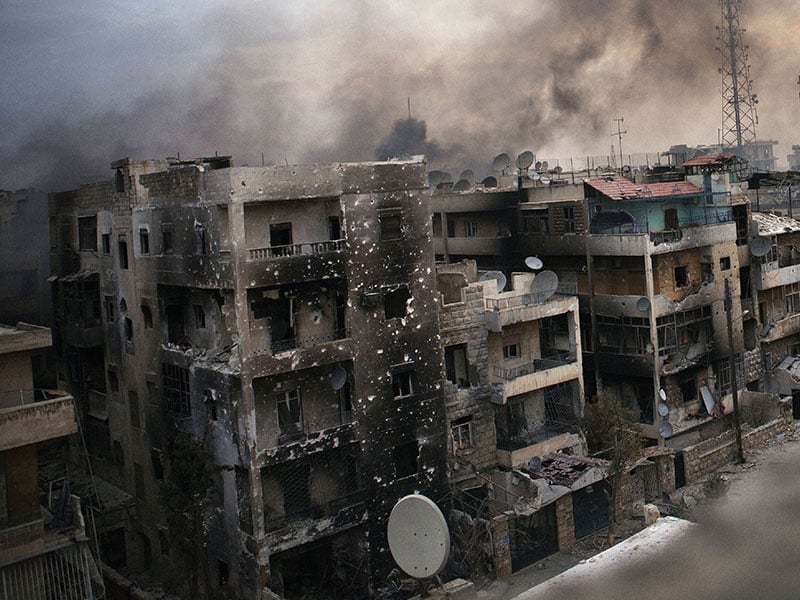Eight years into the conflict in Syria, some 13 million people—more than half of the country’s population—have been displaced from their homes. Some 6 million are internally displaced, while the rest are refugees in Turkey, Jordan, Lebanon, Europe and elsewhere. This is an unprecedented scale of displacement in modern times. Any political solution to the conflict must include mechanisms to protect displaced Syrians from refoulment (being forced to return to dangerous conditions) until the conditions for their voluntary, safe and dignified return are guaranteed by a political agreement, and a robust international mechanism to guarantee and monitor respect for their rights is put in place.
The vast majority of the displaced live in an increasingly difficult situation. Inside Syria they are suffering in dire living conditions, overpopulation and continued attacks by the regime of Bashar al-Assad and his allies. This indiscriminate killing has displaced more than 400,000 people who have fled from Idlib and northern Hama towards the Turkish border since the beginning of the latest military offensive led by Russia and Assad’s regime in February 2019. Despite the harsh living conditions in Idlib caused by the offensive’s intentional destruction of vast amounts of civilian infrastructure, there have been no recorded cases of people fleeing towards regime-held areas. Likewise, residents of Rukban Camp, on the border with Jordan, are under siege and lack basic food and supplies. A UN delegation that visited in August 2019 was shocked by the low number1 of people that wanted to return to regime areas despite the harsh living conditions in the camp.
At the same time, Syrians living as refugees in Lebanon are facing an increasingly harsh situation characterized by a lack of access to basic services and rising anti-Syrian sentiment. The situation in Turkey is worsening due to domestic issues and external pressure, although Turkey is not pressuring Syrians to go back to regime-held areas, but Turkey is planning to populate a potential future safe zone in north-eastern Syria with “at least one million Syrian refugees”2-3.
Syrian refugees in some European countries are also being pressured to return home, with or without a political solution to the conflict or sound international guarantees of the minimum conditions for a safe and dignified return. The Lebanese head of general security recently stated that as many as 200 0004 Syrian refugees have been returned to Assad-held areas in Syria. International agencies, including the United Nations High Commissioner for Refugees (UNHCR), have limited or no access to most of these areas; they cannot monitor the fate of returnees or report on the security threats in regime-controlled parts of the country.
Assad’s regime is intensively implementing a policy of demographic change aimed at stripping a huge portion of the displaced Syrians of their homes and properties through discriminatory laws, demolitions and false “reconstruction” activities. The regime and its Russian allies are desperate for international funds, especially from the European Union, to finance their
“reconstruction” and create new realities on the ground with a multi-pronged effort to Syria’s demographic picture before the organized return of the displaced takes place. To achieve this objective, they are actively promoting a false narrative that the displaced are free to return to Assad-held areas, that the returnees will be safe from persecution and harassment, and allowed to reclaim their properties and enjoy a peaceful life. As this report reveals, nothing could be further from the truth.
This report and its underlying research comprise an unprecedented effort to gather testimonies from people who have returned to Assad-held areas (mostly due to dire living conditions in the displacement locations or because they believed the regime’s promises of safe return) and those who remained in formerly opposition-controlled areas after they were retaken by regime forces under so-called reconciliation agreements. The report documents the security situation of returnees and those living in areas covered by “reconciliation agreements,” as well as their access to basic services, the general living conditions in Assad-held areas, and the views of formerly displaced people on the return process and other relevant issues.
The report has unique value as no international organization, including the UNHCR, has real, uncensored access to all areas under Assad’s control. Gathering information on the security situation, threats facing returnees and the general living conditions in these areas in a systematized way is virtually impossible. The Data Collection and Analysis Unit of the Syrian Association for Citizen Dignity (SACD), a movement fighting for the rights of displaced Syrians, worked in extremely challenging conditions to interview 165 people in Homs, Damascus countryside, Dara’a and Aleppo to obtain a valid, reliable and comprehensive picture of the situation facing returnees in Assad-held areas of Syria.



